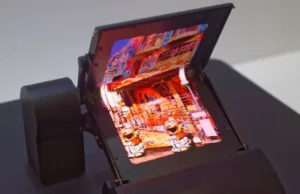AUO had plenty to show at SID, but we were surprised that we were unable to get any information on the 1,000 cd/m² that the company has been working on for HDR monitors with Nvidia and that we saw at CES.
We first looked at new notebook panels made using LTPS LCD technology and with UltraHD resolution in 13.3″ and 15.6″ sizes with slim (1.5mm) borders. The modules were 2.0mm thick and used less than 1.5W (without backlight). We were impressed with the visual quality of the IPS panels and the company’s data showed that the panels had 1,800:1 contrast and 400 cd/m² of output. We thought the contrast was particularly high – IPS is typically 1,000:1 to 1,200:1, but AUO staff did not think it was very exceptional. We went back to discuss the point with a specialist on the next day, but it was not clear that any particular single technique was important, but a full range of improvements in materials and cell structure have led to the good result. Changes include UV alignment and reduced light leakage out of the pixel as well as improvements in the colour filter.
AUO is also working on a 15Hz drive mode for the 13.3″ UltraHD panel that allows a further 40% reduction in drive power. The mode is switchable so that the system can control the refresh based on what is happening on the display.
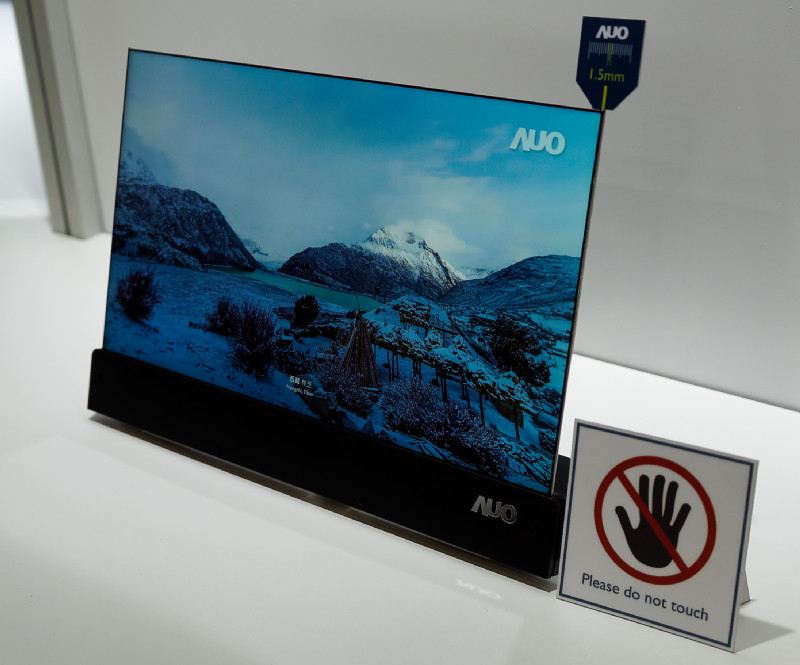
Also on display for notebooks, but this time for gaming notebooks, was a 15.6″ 2560 x 1440 notebook panel that can be driven at 120Hz and with 400 cd/m² of output and 72% of NTSC colour. Response time is 9ms. The panel is being planned for mass production later this year. The performance at the show looked very good and the company also had a 21″ curved (2000R) 21:9 2560 x 1080 with 120Hz refresh and 4ms response time and that is being developed with Acer and Nvidia and, we heard, uses G-Sync technology. The panel supports 95% of NTSC for colour and has 1,300:1 contrast.
A 35″ 21:9 3440 x 1440 panel with 1800R curve is already in mass production and can support refresh up to 200Hz. Brightness is 300 cd/m² and colour is 100% of sRGB. Response time is 4ms and contrast is 2,500:1 and the panel is based on VA technology. AUO aims this panel at professional gaming monitors. Finally, in the gaming section, we looked at a 27″ FullHD panel that supports 240Hz and has a claimed 1ms response time. It has just 1,000:1 contrast and uses TN technology.
Moving to small panels, AUO had a prototype 5″ 720 x 1080 (295 ppi) foldable touch-enabled AMOLED. The panel thickness is just 0.1mm and the panel can be folded to 4R. Surface hardness is 4H and colour gamut is 95% of BT. 2020. AUO designed the TFT to TFE layers to be at the neutral axis of the display. The display is just a prototype at this stage.
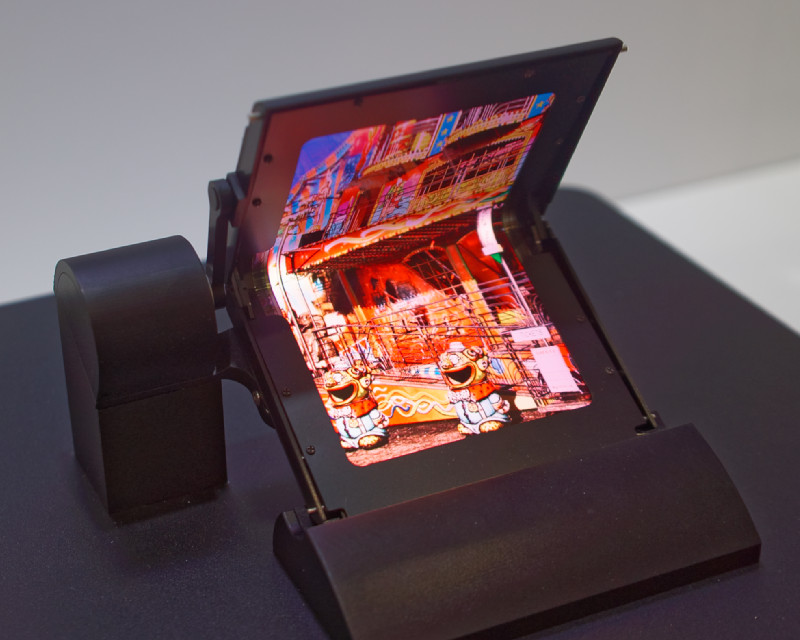 AUO showed this flexible OLED prototype. Image:Meko
AUO showed this flexible OLED prototype. Image:Meko
AUO has had some success with circular OLEDs for smartwatches and wearables and at the show had a new version that it calls ‘True Circle’ and that has a shorter connection tab bringing the display very, very close to completely circular and allowing very slim bezels. AUO said the salient circle is just 2.34mm. The resolution is 454 x 454 (326 ppi) and brightness of the 1.4″ diagonal display is 350 cd/m², while having, AUO claims, 30% lower power consumption than competitive devices. Colour gamut is 100% of NTSC and panel thickness is 0.45mm.
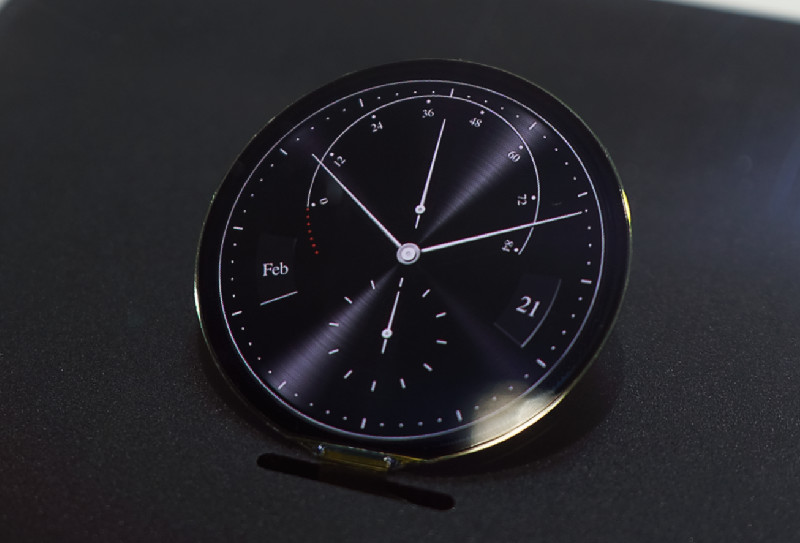 AUO’s new True Circle OLED is very close to a perfect circle. Image:Meko
AUO’s new True Circle OLED is very close to a perfect circle. Image:Meko
Moving to LCDs for smartphones, AUO had a FullHD 5.5″ LTPS panel with 400 cd/m² of output and 2,000:1 contrast using AUO’s AHVA (FFS-like) wide viewing technology. The panel has very narrow bezels for very tight designs. The edge bezels are 0.4mm.
AUO is also working on flexible LCDs and had a 320 x 480 300 cd/m² flexible LCD made on plastic and with 1,000:1 contrast. The plastic substrate is made on a glass carrier and taken off using laser lift-off. The flexible backlight of the display has a special silicone-based LGP with a combination of the diffuser, prism and LGP patterns on a single film and that avoids problems of ‘wet-out’ seen with other silicone solutions. The folding radius is 20R and the total thickness is 1.5mm (the cell, without backlight, is <110 microns). AUO told us that the transistor array is based on amorphous silicon and the plastics are colourless PI. AUO believes that the technology may be seen in ‘S’-shaped displays for centre consoles. (LCDs find it less challenging than OLEDs to meet the lifetime and qualification requirements for automotive applications, so AUO may find some success in that application – Man. Ed.)
 This AUO Flexible LCD might be used in automotive – Image:Meko
This AUO Flexible LCD might be used in automotive – Image:Meko
The next panel we looked at was a 12.3″ FullHD AMOLED with 1920 x 720 (16:6 aspect ratio) resolution and more than 100,000:1 contrast and 600 cd/m² of brightness. Colour gamut is 100% of NTSC. As we reported separately, AUO is working with Corning and Pegatron on curved glass and displays for automotive applications and that demonstration also used a 12.3″ display. Corning Cold Forms for Automotive & Shows Iris LGP for Monitors. AUO also showed a dual version using 12.3″ LCD displays to create a single 27″ display system. The LCDs have 700 cd/m² and 1,000:1 contrast.
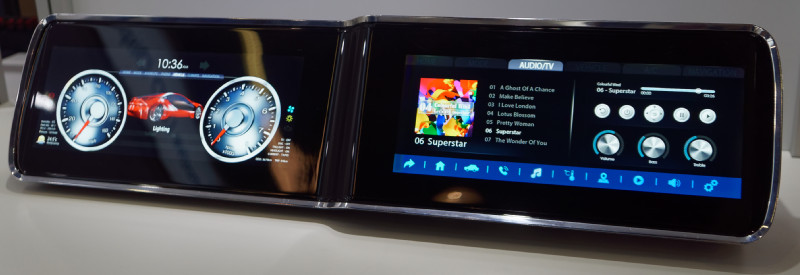 AUO showed this dual LCD for automotive applications. Image:Meko
AUO showed this dual LCD for automotive applications. Image:Meko
There were also for automotive, a 9″ curved LCD with 1280 x 800 resolution and a 700mm radius for centre consoles as well as an 8.9″ rear view mirror display, optimised for a fast response even in cold temperatures (25º C – 20ms; -20º C – 150ms; -30º C – 350ms – all times maxumum) The 1280 x 272 resolution display has 1,200 cd/m² of output and has 40% of mirror reflectance.
The company also had a slightly brighter version with a cell border of 1.0mm and module border of 1.5mm and based on LTPS technology that can be made in ‘free form’ shapes.
 AUO showed this Free Form LCD (note cutout in the bottom edge). Image:Meko
AUO showed this Free Form LCD (note cutout in the bottom edge). Image:Meko
Analyst Comment
This was an impressive set of innovations from AUO which is not going to be able to stay competitive in large TV panels when the Chinese have their G10.5 fabs properly ramped. It’s ability to offer special performance and lower volume products should help the company to continue to develop. I was surprised that AUO didn’t think that 1,800:1 was a particularly good contrast ratio for IPS LCDs. In the absence of Sharp at the expo, AUO must have been happy to get extra attention from companies in automotive and other special areas. (BR)

